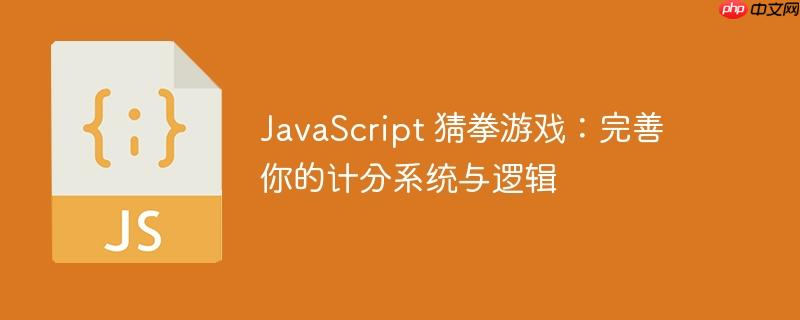
本文将引导你构建一个基于 JavaScript 的猜拳游戏,重点解决计分逻辑问题,并提供更简洁高效的实现方案。我们将深入探讨如何使用数组索引和模运算来简化胜负判断,同时优化用户输入验证,确保游戏的健壮性和用户体验。通过本文,你将掌握编写清晰、可维护的 JavaScript 代码的技巧,并提升解决实际编程问题的能力。
游戏框架搭建
首先,我们需要定义游戏的核心元素:rock(石头)、paper(布)、scissors(剪刀)。 将它们存储在一个数组中,方便后续的逻辑处理。
const choices = ['rock', 'paper', 'scissors']; let playerScore = 0; let computerScore = 0;
电脑的选择
getComputerChoice 函数负责随机生成电脑的选择。
function getComputerChoice() { return choices[Math.floor(Math.random() * choices.length)]; }
玩家的选择与验证
getPlayerChoice 函数负责获取玩家的输入,并进行有效性验证。 使用 prompt 接收用户输入,并使用循环确保输入是 choices 数组中的有效值。
立即学习“Java免费学习笔记(深入)”;
function getPlayerChoice() { let choice; while(true) { choice = prompt('Pick Rock, Paper, or Scissors?').toLowerCase(); if(choices.includes(choice)) return choice; else console.log('Invalid choice, please try again'); } }
胜负判断:核心逻辑优化
playRound 函数是游戏的核心,负责判断胜负并更新分数。 关键在于如何简化胜负判断的逻辑。 我们可以利用 choices 数组的索引,并结合模运算 % 来实现。
核心思想:
- Rock
- 如果玩家的选择的索引比电脑的选择的索引大 1,则玩家获胜(考虑循环,使用模运算)。
function playRound(playerSelection, computerSelection) { if(playerSelection===computerSelection) { return 'Draw' } else if((((choices.indexOf(playerSelection) - choices.indexOf(computerSelection)) + 3) % 3)===1) { playerScore++ return `You win! ${playerSelection} beats ${computerSelection}` } else { computerScore++ return `You lose! ${computerSelection} beats ${playerSelection}` } }
代码解释:
- choices.indexOf(playerSelection) 获取玩家选择在 choices 数组中的索引。
- choices.indexOf(computerSelection) 获取电脑选择在 choices 数组中的索引。
- ((choices.indexOf(playerSelection) – choices.indexOf(computerSelection)) + 3) % 3 计算索引差,并使用模运算处理循环情况(例如,Rock 胜 Scissors 的情况)。
- 如果结果为 1,则玩家获胜。
游戏主循环
game 函数负责控制游戏流程,进行 5 轮游戏,并最终输出结果。
function game() { for (let i = 1; i <= 5; i++) { const playerSelection = getPlayerChoice() const computerSelection = getComputerChoice() console.log(playRound(playerSelection, computerSelection)) } if (playerScore > computerScore) { return 'You beat the computer! You are a genius' } else if (playerScore < computerScore) { return `You got beat by the computer. Practice your throws!` } else { return `You tied with the computer!` } } console.log(game())
完整代码
const choices = ['rock', 'paper', 'scissors']; let playerScore = 0; let computerScore = 0; function getComputerChoice() { return choices[Math.floor(Math.random() * choices.length)]; } function getPlayerChoice() { let choice; while(true) { choice = prompt('Pick Rock, Paper, or Scissors?').toLowerCase(); if(choices.includes(choice)) return choice; else console.log('Invalid choice, please try again'); } } function playRound(playerSelection, computerSelection) { if(playerSelection===computerSelection) { return 'Draw' } else if((((choices.indexOf(playerSelection) - choices.indexOf(computerSelection)) + 3) % 3)===1) { playerScore++ return `You win! ${playerSelection} beats ${computerSelection}` } else { computerScore++ return `You lose! ${computerSelection} beats ${playerSelection}` } } function game() { for (let i = 1; i <= 5; i++) { const playerSelection = getPlayerChoice() const computerSelection = getComputerChoice() console.log(playRound(playerSelection, computerSelection)) } if (playerScore > computerScore) { return 'You beat the computer! You are a genius' } else if (playerScore < computerScore) { return `You got beat by the computer. Practice your throws!` } else { return `You tied with the computer!` } } console.log(game())
注意事项与总结
- 代码可读性: 编写清晰、易于理解的代码至关重要。 使用有意义的变量名和注释,使代码更易于维护。
- 用户体验: 完善的用户输入验证可以提高用户体验。 确保程序能够处理各种异常情况。
- 逻辑优化: 使用数组索引和模运算可以简化胜负判断逻辑,使代码更简洁高效。
- 模块化: 将代码分解为更小的函数,可以提高代码的可重用性和可测试性。
通过本文,你学习了如何构建一个基于 JavaScript 的猜拳游戏,并掌握了优化计分逻辑和用户输入验证的方法。 记住,编写清晰、可维护的代码是成为一名优秀程序员的关键。 持续学习和实践,你将能够解决更复杂的编程问题。
© 版权声明
文章版权归作者所有,未经允许请勿转载。
THE END

















